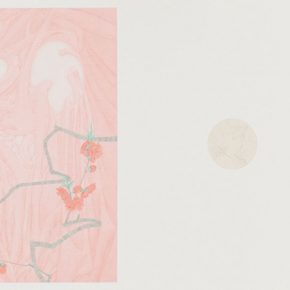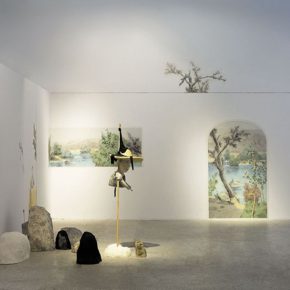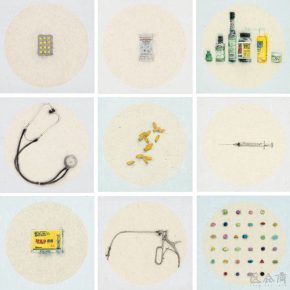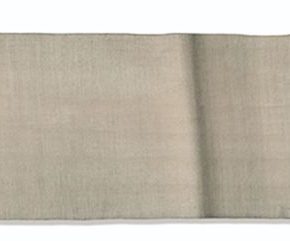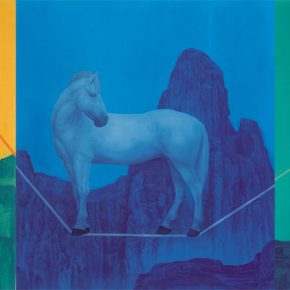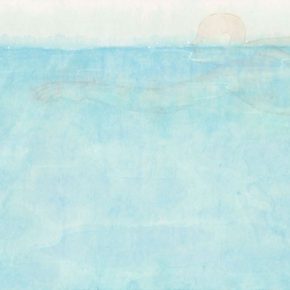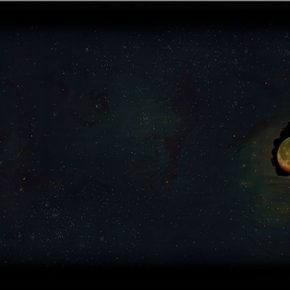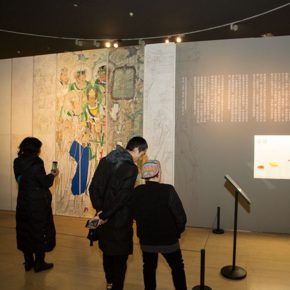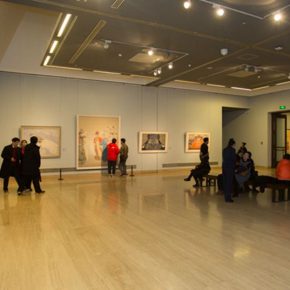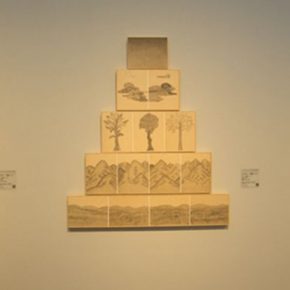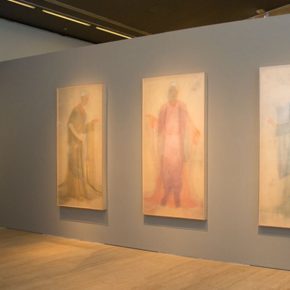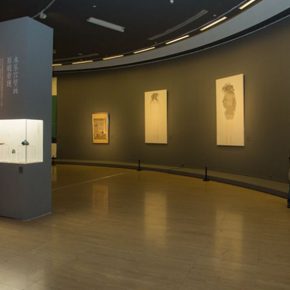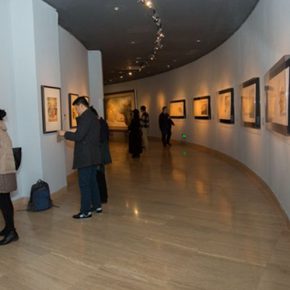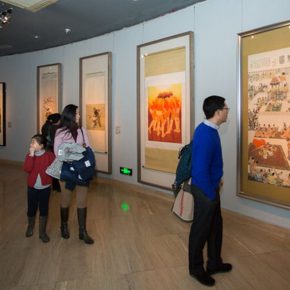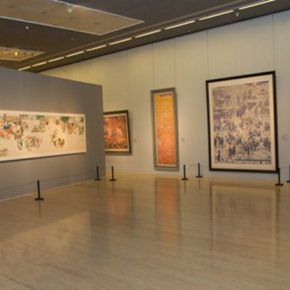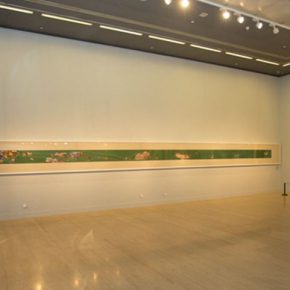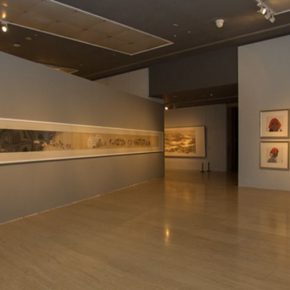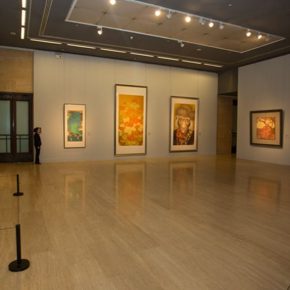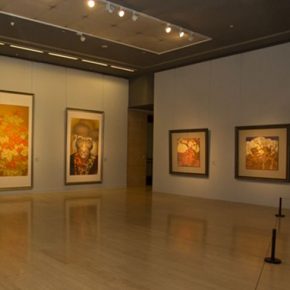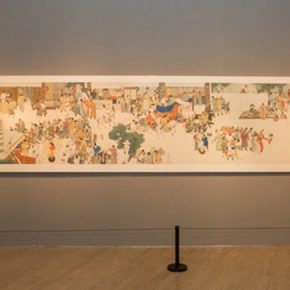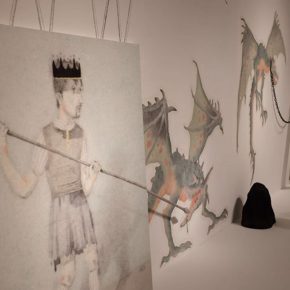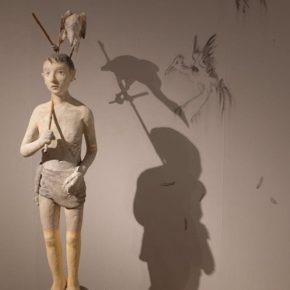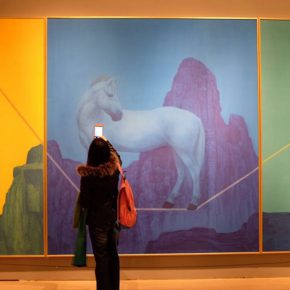
At the end of 2016, the National Art Museum of China celebrated the “Hue Art in the Contemporary Era – The 10th National Exhibition of Chinese Hue Art Paintings 2016”. This triennial exhibition has spanned three decades. As the name suggests, the exhibition has enjoyed nine sessions, and it still takes “Hue Art in the Contemporary Era” as the title, not only focusing on the multi-dimensional practice and exploration in the contemporary field, but also looks forward to its enlightenment in the creation of Chinese Hue Art Painting in future.
Chinese Hue Art Painting has a long history. The earliest work exists now can be traced back to the Chu Tombs at Zidanku in Changsha. Chinese Hue Painting reached the peak period in the Tang and Song dynasties, Emperor Huizong of the Song Dynasty established the Royal Academy of Painting and a large number of professional painters emerged, at the same time a large number of outstanding works emerged including “Beauties Wearing Flowers”, “Ten-Thousand Miles of Mountains and Rivers”, “Han Xizai Night Banquet” and “Auspicious Cranes”. In addition, the prevalence of Chinese hue painting is also reflected in the exquisite mural paintings of the ruins of temples and caves. However, the literati paintings raised in the Yuan Dynasty, till Dong Qichang of the Ming Dynasty advocated the theory of Southern & Northern Schools of Painting, which marked the Chinese Hue Art with the labels of “gradually knowing”, “technology”, “dullness”, which is the opposite of Southern literati painting that upheld “morale, frankness, brush and ink”. In the late Ming Dynasty, the literati painters were criticized by the literati because of their “careless, hasty” style. It was an “interesting and continuous arguing process” on the argument between Chinese hue painting and freehand painting by the professional painters from the academy and literati painters in the Chinese history of art.
The “Hue Art in the Contemporary Era – The 10th National Exhibition of Chinese Hue Art Paintings 2016” held at the National Art Museum of China is divided into three parts: the Historical Review Exhibition, Academic Nomination Exhibition and National Award-Winning Exhibition. “The Historical Review Exhibition” showcases the works by Feng Dazhong, He Jiaying, Liu Jingui, Xiao Yutian, Niu Kecheng who are from the field of Chinese Hue Art Painting; “Academic Nomination Exhibition” is directed by President of CAFA Fan Di’an who invites Liu Qinghe, Chen Xiangbo, Wu Hongliang, Hang Chunxiao, He Guiyan to constitute the nomination committee, to introduce the “Academic Nomination Exhibition” which is the most important academic part of The 10th National Exhibition of Chinese Hue Art Paintings; In addition, “National Award-Winning Exhibition” is intended to showcase some new powers in the field of Hue Art under the novel and changing social trends.
Chinese Hue Art Painting has been revived since the 1980s, and it had a new influx of modern art trends after the revival of the Cultural Revolution, the liberation of thought and the freedom of spirit gave birth to a thriving art movement, the development of contemporary painting can be considered the response to the theory of “Improving Chinese Painting” in the early last century. Chinese Hue Art Painters might blend the formal processing techniques of drawing, shaping and color with the material and painting skills of traditional Chinese Hue Art Painting and learned from the images and concepts of Western classical art or modern art, to actively explore the road of innovation and change. The participating artists including Xu Lei, Zhang Jian, Hang Chunhui, Gao Qian are all considered to be representatives of “New Chinese Hue Painting”, the works “Like a Dream” (Xu Lei, 2015), “Collection of Spring – Condensed Snow” (Zhang Jian, 2015) reflect the spirit of the image with an individual conceptual expression, in the use of the image form and color language, it presents an illusive elegance and gorgeous aspect which is a “visual construction” of the “spirit of an human” in the state of contemporary life, behind these works it reveals the painters trying to get rid of the traditional language and trying to use new language to express themselves.
The exhibition first introduces the concept of “ink and wash”, Liu Qinghe, Deputy Dean of the School of Chinese Painting is one of the nominating members of this academic nomination exhibition and most of his nominated artists are related to ink and wash, he believes that, “the scope of painting should not be defined by a technique”, we can see many works by the artists of ink and wash, including “Integration” and “Registration” series by Zhang Yanzi, the second one finishes with the medical equipment, drugs, capsules which represent modern medical practice as a visual spectrum, to showcase the excessive dissipation and void of the materialism of modern life, while the up-to-6-meter long scroll of ink landscape entitled Qi (Flow of Energy) is hung at the top of the exhibition hall, with a perception of crossing; Li Geye’s quadruple group paintings entitled “Unbounded” combine the “Chinese Hue Art Painting” and “Freehand Painting” to showcase the wandering state of existence and the empty spiritual world in contemporary society. Yan Hairong’s “Gate of the Mountain” reinterprets the “stones are composed of three faces” which is the method for building the volume of the traditional landscape…
The exhibition aims to explore the openness of the language of Chinese ink and brush, while Chinese Hue Art Painting is just a starting point. As one of the participating artist Zhang Yanzi says, it is not necessary to discuss whether it is a work of Chinese Hue Art Painting, the material is only a medium. The creative process of the thinking of the artist is the first point: “Ancient Chinese painters did not define themselves to engage in the creation of Chinese painting, they did nothing but use the material to express their feelings.” In addition, it also features the works involved in the installation and image including Ma Lingli’s “A White Horse is Not a Horse”, Zeng Jianyong’s “Repeated Paradise”, the painting of the ready-made article “The Shadow Standing, Alone, Isolated Shadow” by Jiang Ji’an, Wang Yu’s installation of light box “Relationship of Collusion”, Tu Shaohui’s work of image on silk, entitled “Ferry of Ximu No.3”. “From the curatorial perspective, we also need some artists to walk on the edge so that we can more accurately understand what is Chinese Hue Painting,” Wu Hongliang, Director of the Art Museum of Beijing Fine Art Academy is one of the nominating members of this academic nomination exhibition, and he says, “The inclusion of these works expands the scope of Chinese Hue Art Painting, while it also helps academics to clarify what is Chinese Hue Art Painting.” We can observe that no matter what kind of material is used in the creation by these artists, whether they use ink or color, they all reveal a trend of “changing technology to way”: the “Technological Mind” that is in pursuit of the precision of all things is changed to the “Literary Mind” that is in pursuit of the artist’s individual life insights and inner cleanness.
So, what is the value of Chinese Hue Art Painting in such rapidly changing times? The academic director of the exhibition, President of CAFA Fan Di’an points out three dimensions of “Hue Art in the Contemporary Era”, first of all, it is the value of “Hue Art” in the creative spirit; secondly, it is the unique artistic conception and rich details of formal language, allowing people to settle down to taste art in today’s fast-paced life, fostering the spirit; thirdly, Chinese Hue Art Painting is an open field, and it has different characteristics in different times during the historical development, to express the images of life, social concerns, and even the pursuit of aesthetics in different times. Chinese Hue Art Painting has been able to stretch for thousands of years, has an inexhaustible vitality due to its open visual thinking and artistic expressive system and it offers a possibility to melt the West and China, connecting the ancient and the present in the media, skills and display modes, which is the purpose of the exhibition, showing diverse development paths in contemporary painting, intended to have a positive role in promoting the development of contemporary Chinese Hue Art Painting.
Text by Lin Jiabin, translated by Chen Peihua and edited by Sue/CAFA ART INFO
Photo by Hu Sichen and Yang Yanyuan/CAFA ART INFO


